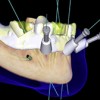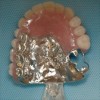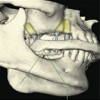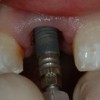Surveyed crowns are fabricated for patients to be fitted with removable partial dentures when correction of acceptable tooth contours cannot be achieved with modification alone of the occlusal surfaces of the residual teeth. Crowns on teeth are used to correct occlusal plane discrepancies, to restore badly broken down clinical crowns, to create proper rests, particularly with anterior teeth, and adequate retentive undercuts for direct retainers (I-bar, C-clasp) and guide planes when inadequate contours exist. This program details the methods used to design and fabricate surveyed crowns and the management of combined fixed-removable cases.
Removable Partial Dentures – Surveyed Crowns and Combined Fixed RPD Cases — Course Transcript
- 1. Surveyed Crowns and Combined Fixed-RPD Cases Aria Davodi DDS and Ting Ling Chang DDS Division of Advanced Prosthodontics UCLA School of DentistryThis program of instruction is protected by copyright ©. No portion of thisprogram of instruction may be reproduced, recorded or transferred byany means electronic, digital, photographic, mechanical etc., or by anyinformation storage or retrieval system, without prior permission.
- 2. Surveyed crowns and combined fixed RPD cases Varies from extensive rehabs to when the fixed is confined to abutments associated with the RPD.
- 3. Surveyed crowns and combined fixed RPD casesVaries from extensive rehabs to when the fixed isconfined to abutments associated with the RPD.
- 4. Surveyed crowns and combined fixed RPD casesVaries from extensive rehabs to when the fixed isconfined to abutments associated with the RPD.
- 5. Surveyed crowns and combined fixed RPD casesVaries from extensive rehabs to when the fixed isconfined to abutments associated with the RPD.
- 6. When Does One Choose to Fabricate a Crown to Serve as a Removable Partial Denture Abutment?v When correction of unacceptable tooth contours cannot be achieved through enamel modification alone
- 7. When does one choose tofabricate a surveyed crownv To restore a badly broken down clinical crownv To reestablish a proper occlusal plane (i.e. supra-erupted teethv To create proper rests, particularly with anterior teeth, and adequate retentive undercuts for direct retainers (I-bar, C- clasp) and guide planes when inadequate contours exist.
- 8. Objectives of Modifying Abutment Tooth Contoursv Develop an acceptable path of insertion for the RPDv Promote favorable biomechanical properties. v Retention v Stability v Supportv Improve Esthetics Stability Support Retention
- 9. Combining Fixed Restorations and Removable prostheses–Treatment SequenceDiagnosis Determine that a surveyed crown or crowns are needed RPD design is based on support, Design stability, and retention Fixed Restorations Removable Prostheses
- 10. Surveyed Crown Fabrication–Treatment Sequencev Mount study casts with a facebow record and preferably in centric relationv Fabricate treatment RPD’s as necessaryv Surveyed diagnostic wax-up with guide planes and occlusal restsv Duplicate diagnostic wax-up and generate a stone castv Fabricate preparation guidesv Prepare and temporize abutments v Prepare guide planes and rest seats on other RPD abutments based on the established RPD design v Adapt treatment RPD’sv Final FULL ARCH impressionv Obtain facebow record to mount maxillary cast*
- 11. Surveyed Crown Fabrication–Treatment Sequencev Make centric relation or maximum intercuspation record to mount the mandibular cast* v Record bases fabricated if inadequate number of teeth remainv Survey full contoured crown wax-up including all RPD componentsv Wax cut back if metal PFM restorationv Cast, fit to die, metal try-in to verify fit of casting, occlusion if applicablev Porcelain bisque survey, and try-in – verify interproximal contacts, occlusion, fit, guidance, estheticsv Porcelain glaze, and final cementationv Refinement of other RPD abutments (guide planes, rest seats, facial / lingual heights of contour for retainers) and final RPD framework impressionv Finish the RPD in the usual manner
- 12. Treatment RPD’sPatient presents with: v Missing posterior occlusion v Moderate wear with reduced vertical dimension of occlusion v Unfavorable tooth contours for RPD Support and retention
- 13. Surveyed Crowns -Treatment SequencevMount study casts with a facebow record preferably in centric relationvCase should be mounted at the proper vertical dimension and when necessary using record bases and wax rims.
- 14. Surveyed Crowns -Treatment SequencevForfixed and removablecombination cases always comeup with the RPD design during thediagnosis & treatment planappointmentvSurvey and determine the MAPfor RPD
- 15. Surveyed Crowns -Treatment Sequencev For fixed and removable combination cases always come up with the RPD design during the diagnosis & treatment plan appointmentv Survey and determine the MAP for RPD
- 16. Treatment RPD’s – Purposev Replace missing teethv Establish posterior occlusionv Test changes in vertical dimensionv Trial prostheses—See if patient can adapt to removable prostheses
- 17. Treatment PartialsNote occlusal platform onmaxillary treatment partialto restore patient’s verticaldimension
- 18. Surveyed Crown Fabrication Pre-clinical Diagnostic proceduresPerform a diagnostic wax-up of teeth that are to receive surveyed crownsv Surveyed diagnostic wax-up with guide planes and restsv Correct tooth angulation problemsv Correct occlusal plane problemsv Determine the proper path of insertion of the eventual RPD by surveying the wax-up. Carve rest seats, guide planes, and heights of contour for your retainers(I-bars, C-Clasps) in wax.
- 19. Diagnostic Wax-upvFull contoured wax-up is performed for teeth that are to receive crowns • Carve rest seats, guide planes, and Rests carved in wax. heights of contour for (Additional tooth reduction will be your retainers (I-bars, required in these areas) C-Clasps) in wax.
- 20. Diagnostic Wax-upvSet the denture teeth and establish the desired occlusal planevScheme of occlusion based on the situation existing in the weakest arch.
- 21. Surveyed Crown Fabrication Pre-clinical Diagnostic proceduresv Duplicate diagnostic wax-up by making an alginate impression and pouring a stone cast.v Fabricate preparation guides v Vacuum formed matrix (suck- down) to serve as a tooth preparation guide and a matrix to fabricate a provisional (temporary) restoration.
- 22. Preparation guidesThis type of guide is useful when preparing fixedpreparations so that all the guide planes of the finishedrestorations will be parallel to one another.
- 23. Preparation guidesvPreparethe guiding surfaces on all RPDabutment teeth before beginning any restorationvThen the preparation for the restoration canbegin following the MAP
- 24. Tooth Preparation and Provisionalization New treatment partials were fabricated to fit provisional restorations
- 25. Tooth Preparation and Provisionalization New treatment partials were fabricated to fit provisional restorations Before provisionals After provisional
- 26. Tooth Preparation and ProvisionalizationNew treatment partials were fabricated to fit provisional restorations Before After
- 27. Surveyed Crown Fabrication—Tooth Preparation, Impression Makingv Full arch impressionv Send case to laboratory to pour, pindex, separate from base.v Ask laboratory not to section between preps, or trim your dies and return your master cast for record base fabrication and mounting of the case. Master cast Final FULL ARCH impression Base
- 28. Surveyed Crown Fabrication—Mounting Casts l Fabricate record bases l Add wax rim l Determine vertical dimension of occlusion. l Determine anterior tooth position and proper lip support l Establish occlusal plane l Mount the maxillary cast with a facebow transfer and the mandibular cast with a centric relation record.
- 29. Record bases fabricated on master casts Wax-rims addedDetermine VDO, occlusal plane, proper anterior tooth displayand lip support clinically. Mount maxillary cast with facebowtransfer record and mandibular cast with a centric relation record •-Set teeth •-Confirm vertical dimension •-Determine proper tooth position, •-Verify mounting •-Begin surveyed crown fabrication
- 30. Surveyed Crown Fabrication – Laboratory Procedures 1. Set adjacent and opposing teeth 2. Trim dies 3. Perform a full contoured wax-up. Place on surveyor, establish path of insertion (MAP), carve rest seats, guide planes, Facial, lingual heights of contour for direct retainers (I-bars, C-Clasps) and reciprocating arms or elements (i.e. minor connectors, proximal plates, partial lingual plates.) 4. Perform wax cut back for porcelain fused to metal (PFM) restorations. 5. Sprue, invest, cast, divest crown. Fit crown to die
- 31. Survey master cast to determine RPD path of insertion (MAP), tripodize castPerform a full contoured wax-up according to your MAP, determineocclusion (set adjacent and opposing teeth) Guide planes and rests should be in metalMaximize guide planeheight and width to Survey for tissue undercuts on Positive cingulumoptimize stability a solid model to aid in retainer rest design Cut back wax-up for PFM fabrication. Maximize height and width of Guide planes to enhance RPD stability, make sure rests are positive.
- 32. Surveyed Crownsv Perform metal try-inv Why?
- 33. Why Perform a Metal Try-in?l Determines whether your master impression was accurate prior to porcelain applicationl Determines marginal fidelity, retention, resistance form of your restorationl Determines the accuracy of your occlusion and interproximal contacts in full metal restorationsl Determines the proper fit (without rocking) of splinted crowns and bridges
- 34. Surveyed Crown – Porcelain Bisque Try-inv Bake porcelain. Place on surveyor to establish contours based on the RPD’s path of insertion (MAP).v Place crowns on a solid master cast (dies not trimmed) to evaluate tissue contours, survey, make all changes in porcelain.
- 35. Surveyed Crown – Porcelain Bisque Try-inl Survey master cast, reestablish determine most advantageous position (MAP)l Adjust guide planes, buccal and lingual contours to optimize parallelism and undercuts for direct retainers (I-bars, C- clasps)l Make sure all rests are positive. Be careful not to perforate rest seats while adjusting. Measure depth of metal with calipers. Minimum metal depth should be 0.5 mm.l Refine occlusion
- 36. Surveyed Crown Fabrication Porcelain Bisque Try-in Use carbides or stones to adjust metal, diamonds to adjust porcelain. Polish all adjustments with silicone carbide wheels. Long, wide guide planes maximizeNote the perfect location for I-bar. 0.01” stability, and minimize tissueundercut at the cervical 1/3 of crown hypertrophy under RPD frame.
- 37. Completed Crown Check ListvParallel Guiding Surfaces (in metal)vPositive restsvRetention in the cervical onethird of the tooth
- 38. Surveyed Crown Fabrication Porcelain Bisque Try-inTake to mouth for try-in. v Check interproximal contacts v Check Margins v Check Occlusion v Check Shade
- 39. Surveyed Crown Fabrication Final DeliveryAfter all adjustments arecompleted:v Glaze Porcelainv Polish Metalv Cement Crownsv If treatment partials present, plan for their adjustment to fit around new crownsv Make final RPD impression in alginate capturing all soft tissue (denture bearing surfaces) detail.
- 40. RPD Framework FabricationAlginate impression for RPD framework must capture all tissue detail Retention in The retromolar pads cervical third andthe retromylohyoid area have been captured in the alginate impression Long, parallel guide plane Once happy with the RPD’s path of insertion, tripodize cast
- 41. RPD Design Cast
- 42. RPD Fabricationv Framework designv Write laboratory work authorization, send case to lab for framework fabricationv Try RPD framework v Make sure it is fully seated v Physiologic adjustment v Adjust occlusionv Altered cast impression in extension base RPD’sv Fabricate record base, wax rim, mount casev Set denture teethv Tooth try-in clinically v Verify mounting v Verify estheticsv Process and delivery
- 43. RPD Fabrication is completed in the usual wayvAltered cast impressionsvCR recordsvSet teethvOcclusion based on the weakest archvEsthetic try in
- 44. RPD OcclusionBased on the weakest arch v One arch edentulous – Bilateral balanced occlusion v Both arches partially dentate – Anterior guidance or group function Bilateral balance Anterior guidance
- 45. Delivery sequencev Seat dentures using PIPv Verify extensions with periphery waxv Adjust occlusion following clinical remount.v Followup instructions
- 46. Case presentationPatient presents with: v Missing posterior occlusion v Reduced vertical dimension of occlusion v Moderate attrition v Unfavorable tooth contours for RPD Support and retention
- 47. Tooth Preparation and Provisionalization New treatment partials were fabricated to fit provisional restorations
- 48. vFinal FULL ARCH ImpressionsvMaster casts pindexed, bases to be pouredvCase to be mounted using record bases and wax rims
- 49. Metal Try-InPorcelain Try-In
- 50. RPD Fabrication is completed in the usual wayvAltered cast impressionsvCR recordsvSet teethvOcclusion based on the weakest archvEsthetic try in
- 51. Surveyed Crown/Bridge DeliveryMake sure all cement is Note POSITIVEremoved cingulum rests
- 52. RPD Delivery
- 53. Final ResultBefore After
- 54. Case presentationl Patient presents S/P resection of the soft palate for a squamous carcinoma
- 55. Surveyed Crowns RPD framework
- 56. Surveyed Crownsv Completed RPD with obturator prosthesisv Note there are only two direct retainersv Enhancement of vertical support is provided by the engagement of the root of the right cuspid
- 57. Surveyed Crownsv Patient presents status post resection of right posterior alveolar ridge and soft palate for a squamous carcinomav Preparations have made for surveyed crownsv The metal work is tried in to verify marginal integrity and occlusion
- 58. Surveyed Crownsv Porcelain is added and the restorations are cementedv Impression is made in preparation for fabrication of the RPD framework
- 59. Surveyed CrownsRPD design and completed framework v Note the bracing via the lingual plate. This is required because of the lateral forces applied to the obturator extension during speech and swallowing. v The long length of lever arm of the soft palate obturator will increase the magnitude of the forces, hence the need for increased bracing
- 60. Surveyed CrownsRPD design and completed framework v Note the cingulum rests on the cuspids and the mesial rest on the right premolar v There are only two direct retainers v Note the fulcrum line. Indirect retention is provided by the rests on the left cuspid and premolar and the lingual plate
- 61. Surveyed Crownsv The RPD framework is tried in and physiologically adjustedv An altered cast impression of the residual alveolar ridge and soft palate defect is obtained with compound and a thermoplastic wax
- 62. Surveyed Crownsv The completed prosthesis
- 63. v Visit ffofr.org for hundreds of additional lectures on Complete Dentures, Implant Dentistry, Removable Partial Dentures, Esthetic Dentistry and Maxillofacial Prosthetics.v The lectures are free.v Our objective is to create the best and most comprehensive online programs of instruction in Prosthodontics


 Computer Guided Treatment Planning and Surgery
Computer Guided Treatment Planning and Surgery
 Implants and RPDs
Implants and RPDs
 Angled Implants
Angled Implants
 Single Tooth Defects in Posterior Quadrants
Single Tooth Defects in Posterior Quadrants
